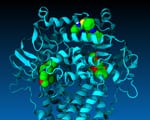Goal is to create wearable device that helps pediatric patients avoid asthma attacks
Two SMU psychology professors working with University of Maryland engineers have been awarded a National Institutes of Health grant in October that will bring nearly $2 million to their joint project to create a wearable device for pediatric asthma patients that helps them avoid asthma triggers.
The asthma device will monitor air quality (including pollen levels and temperature), carbon dioxide levels in the blood, physical activity, breathing, emotional states and other stimuli to identify each patient’s individual asthma triggers and alert them when conditions are ripe for an attack. The concept is similar to the glucose monitor that alerts diabetes patients when their blood sugar is low, but it also includes much more complex monitoring of the patients’ environment.
The device’s current iteration is a portable unit, but the Maryland team is miniaturizing it so that it can be worn as a vest.
SMU psychology professors Alicia E. Meuret and Thomas Ritz, have teamed up with University of Maryland Center for Advanced Sensor Technology professors Yordan Kostov, Xudong Ge and Govind Rao, which provides a natural extension of each team’s research.
“Most of my early research has been developing a treatment that addresses hyperventilation using portable CO2 measurement devices, and teaching patients who suffer from panic disorders to normalize their CO2 levels and stop hyperventilating,” said Meuret, an associate professor in SMU’s Department of Psychology. “The colleagues at University of Maryland contacted me because they wanted to use one of the refined devices as a therapeutic measure, and the partnership grew from there.”
One eventual goal for the academic partnership is for the device to provide Meuret’s treatment instructions to patients during an attack so they can more quickly recover.
How patients perceive asthma triggers and how they can better manage them has been Ritz’ major research interest. He says 25 percent to 30 percent of patients have asthma symptoms triggered by emotional stimuli, which can be demonstrated by experiments with mood induction.
“That percentage is clinically significant,” Ritz says. “It’s a large endeavor with researchers from across the United States working on it and exchanging experience to develop their projects further.”
While the Maryland team works on the hardware for the project — and other research teams across the country work on the software — SMU’s Ritz and Meuret are working on the psychology and the clinical testing of the device with patients. Starting in January, the pair will conduct tests where students wearing the sensors change their breathing systematically or watch mood-inducing stimuli, such as sad, frightening or joyful movie clips.
Other tests of the environmental sensors will be done with adolescent asthma patients’ daily life. This will generate the data that will make the device’s components eventually run smoothly.
The SMU allotment of the NIH grant’s funds is $540,737. The University of Maryland team also includes environmental engineering researchers Chris Hennigan and electrical engineering researchers Ryan Robucci and Nilanjan Banerjee. — Kenny Ryan
Follow SMUResearch.com on twitter at @smuresearch.
SMU is a nationally ranked private university in Dallas founded 100 years ago. Today, SMU enrolls nearly 11,000 students who benefit from the academic opportunities and international reach of seven degree-granting schools. For more information see www.smu.edu.
SMU has an uplink facility located on campus for live TV, radio, or online interviews. To speak with an SMU expert or book an SMU guest in the studio, call SMU News & Communications at 214-768-7650.


 Top Quark: New precise particle measurement improves subatomic tool for probing mysteries of universe
Top Quark: New precise particle measurement improves subatomic tool for probing mysteries of universe New fossils intensify mystery of short-lived, toothy mammals unique to ancient North Pacific
New fossils intensify mystery of short-lived, toothy mammals unique to ancient North Pacific Drugs behave as predicted in computer model of key protein, enabling cancer drug discovery
Drugs behave as predicted in computer model of key protein, enabling cancer drug discovery Researchers discover new drug-like compounds that may improve odds for men battling prostate cancer
Researchers discover new drug-like compounds that may improve odds for men battling prostate cancer